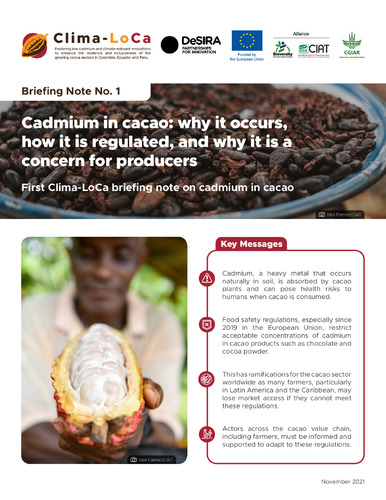Cadmium in cacao: why it occurs, how it is regulated, and why it is a concern for producers
The Clima-LoCa project is a regional project led by the Alliance of Bioversity International and the International Center for Tropical Agriculture (CIAT), implemented with research partners from Latin America and Europe and funded by the European Commission. This project contributes to the objectives of the 2018 call for “Climate- Relevant Innovation through Research in Agriculture” of the EC-led platform DeSIRA (Development-Smart Innovation through Research in Agriculture), based on the ambition to improve research mobilization and innovation capacity contributing to the sustainable development of the cacao sector. The project addresses important challenges related to the resilience, competitiveness, and inclusiveness of the growing cacao sector. Here, resilience refers to the capacity of smallholder producers, and other value chain actors, to mitigate the negative impacts of new EU food safety regulations on cadmium in cacao, and of climate change. https://climaloca.org/. This first Policy Brief of the Clima-LoCa project deals with commonly asked questions about the origin of cadmium in cacao and about the interpretations and consequences of the EU food safety regulations. Key Messages: plants and can pose health risks to humans when cacao is consumed; food safety regulations, especially since 2019 in the European Union, restrict acceptable concentrations of cadmium in cacao products such as chocolate and cocoa powder. This has ramifications for the cacao sector worldwide as many farmers, particularly in Latin America, may lose market access if they cannot meet these regulations; actors across the cacao value chain, including farmers, must be informed and supported to adapt to these regulations.

